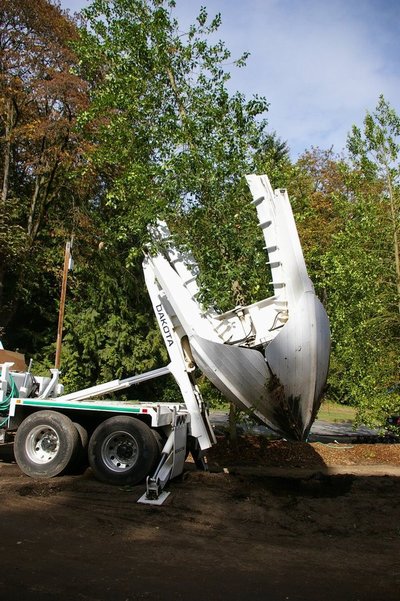October 11, 2007
New garden makes Pacific Connections
This morning’s groundbreaking for the Pacific Connections Garden, the largest garden added to the Washington Park Arboretum since its founding, was preceeded in recent weeks by the moving of holly trees and shrubs — some as tall as 30 feet — and by a plant collecting expedition to Oregon’s Siskiyous, the first in a series of expeditions to bolster plant collections for the new garden.
The groundbreaking ceremonies, including placing a cedar column designed by artist Milenko Matanovic as a support for the interpretive shelter that will be built this year, involved the general public and representatives from the UW Botanic Gardens and Seattle Parks and Recreation, which operate the arboretum with support from the Arboretum Foundation. The new garden will be at the southern end of the arboretum and feature plants from Australia, New Zealand, China, Chile and the Pacific Northwest.
The arboretum’s holly collection, second in the nation only to the National Arboretum in Washington, D.C., had to be consolidated at a new site to make way for the Pacific Connections Garden. In the largest plant-moving project ever at the Washington Park Arboretum, a tree spade was used in mid-September to move 35 trees and shrubs.
But the work in preparation for moving day was actually more than two years in the making, according to Fred Hoyt, grounds manager for the UW Botanic Gardens who oversaw the project.
Considering its value and the fact it is nationally recognized, Hoyt says some of the earliest steps involved collections manager Randall Hitchin leading efforts to assess the holly collection and determine how best to display them. It was decided to group them according to their respective “clades” based on the most current DNA analyses research of the genus Ilex. Care was taken to determine such things as which were the most valuable species and which plants to move and which to take cuttings from for propagation.
Iain Robertson, UW associate professor and chair of landscape architecture, was enlisted to develop a plan for a holly garden at its new location on the slopes, just north of the arboretum’s Japanese Garden. Among his challenges was considering the species that may be added to the collection in the future as well as site conditions so the plants can thrive. With a great deal of surface and subsurface water, Seattle Public Utilities was consulted and a plan developed to incorporate swales — broad, shallow channels — where native plants will be grown as a cost-effective way to manage excess water at the site.
The preparation of the site was done earlier this year under the direction of Erik Brihagen, a UW heavy equipment operator lead. The crews he leads do a range of work on campus including leaf sweeping campus roads and trenching for sewer and water line work.
Working for six weeks, the crew removed brush, old tree roots and stumps and then started regrading to create the berms in which Robertson wanted the hollies placed. One part of the site in particular was “steep, uneven and unruly — not even close to Robertson’s vision of how the plants should be arranged,” Brihagen says. That took a lot of work with a topographical map and an eye for grading. Then 700 yards of new soils were brought to the site and mixed according to Robertson’s specifications.
Hoyt described the efforts of Brihagen and the other heavy operators as “fine crafting the area for the holly collection.”
Working with Brihagen as on-site coordinator was David Zuckerman, supervisor of horticultural staff with the UW Botanic Gardens who last year ensured that the hollies that needed to be moved were root pruned in preparation. He was also there, along with the arboretum horticulture staff, overseeing and implementing moving week when the contractor hired by the city established the collection at its new site. Work that remains at the site includes moving the arboretum’s larch collection there to serve as a backdrop and installing native plants such as snowberry and native sword ferns in the swales.
The Pacific Connections Garden is the most visible project to date of the Washington Park Arboretum’s 20-year plan for renewing plant collections, grounds, visiting amenities, educational resources and facilities.
“As other parts of the master plan are implemented, it will be much like this effort with a considerable amount of attention given to existing collections,” Hoyt says.
“This move does justice to one of our most significant collections, bringing it up to scratch with our Pinetum, recently restored, and our collections of oaks and maples, both of which are the most significant in terms of number of species and cultivated varieties in North America,” says David Mabberley, director of the UW Botanic Gardens, which are a part of the UW’s College of Forest Resources. “The UW is the steward of these state assets in the same way that the Burke museum stewards its collections.”
Another step toward establishing the new Pacific Connections Garden was a plant collecting expedition to the Siskiyous led by collections manager Hitchin at the end of September. The four-person expedition, with a target list of 50 or 60 trees and shrubs, worked 10 to 12 hour days.
The Siskiyous have extraordinary diversity, Hitchin says. For one thing, that area was not covered by glaciers that wiped out plants in other parts of the Pacific Northwest. This expedition is the first in a series — including one planned to China and others proposed for Chile, New Zealand and Australia — to build the collections representing the Pacific Rim in the new garden.

